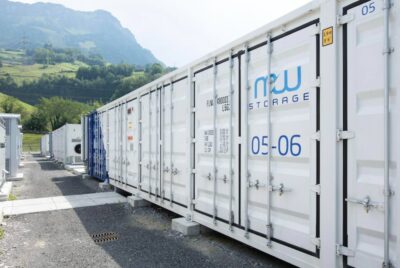

Batteries in a Constrained World: Evaluating Grid Constraints for BESS Projects (Part 1)

As grid access points for Battery Energy Storage Systems (BESS) become increasingly constrained, project developers and investors face a growing challenge. At Entrix, we’ve observed that successfully navigating grid constraints is critical to ensuring the viability of BESS business cases. But to truly evaluate the impact of these constraints, it’s essential to understand how batteries behave in different markets and seasons.
In this first part of our mini-series, we’ll explore the framework for evaluating grid constraints, starting with the three crucial steps every developer and investor should follow. Future installments will dive deeper into real-world examples of how these constraints play out.
How to Evaluate Grid Constraints?
Grid constraints can seem complex, but evaluating them effectively boils down to three critical steps:
- Understand BESS Dispatch Behavior: A thorough grasp of how BESS operates is essential. This includes understanding the seasonal dynamics of battery dispatch and its role in different energy markets.
- Analyze the Nature of Grid Constraints: Identify when, how, and to what extent constraints are applied by grid operators.
- Integrate the Two Perspectives: Combine insights on BESS behavior and grid constraints to evaluate their overall impact on a project’s business case.
These steps require careful analysis, not just of operational data but also of market conditions and regulatory frameworks. Developers and investors who master this process are better positioned to mitigate risks and optimize project outcomes. Let’s dive into Step 1: understanding how BESS operates across seasons and markets.
Step 1: Understanding BESS Behavior
Battery energy storage systems are versatile assets that typically serve two primary functions:
- Arbitrage Trading: Charging during low-price periods and discharging during high-price periods to capture market spreads.
- Ancillary Services: Participating in markets like Frequency Containment Reserve (FCR) and automatic Frequency Restoration Reserve (aFRR) to support grid stability.
This dual functionality is highly influenced by energy prices and the generation mix, leading to distinct seasonal patterns. Additionally, the interplay between different market opportunities means BESS operations can shift significantly depending on market volatility and pricing signals.
Winter vs. Summer Dispatch Profiles
In winter, characterized by lower solar generation, BESS typically charges during nighttime low-price periods and discharges during morning and afternoon/ evening demand peaks. This pattern aligns with higher evening electricity demand as households and industries ramp up energy usage. Summer dispatch, on the other hand, is dominated by high solar generation during the day, with batteries charging during midday low-price periods and discharging during morning and evening peaks. This reflects the influence of solar photovoltaic (PV) generation on energy markets, creating what’s often referred to as the “duck curve.”
By understanding these seasonal differences, developers can better anticipate revenue fluctuations and operational challenges. For example, in winter, when energy demand peaks during evening hours, BESS operations may require greater attention to ensuring sufficient nighttime grid capacity to charge the batteries efficiently. Conversely, in summer, with abundant midday solar production driving down energy prices, operational strategies must focus on capitalizing on this low-cost charging window to maximize arbitrage opportunities.


Market-Specific Dynamics in Summer
Summer’s dispatch patterns can be broken down further based on market participation. These categories reflect the different monetization approaches and operational dynamics of battery dispatch:
- Trading the “fundamentals” (Day-Ahead market, DAA): This category is driven by predictable supply and demand dynamics. Batteries participate in the Day-Ahead market to capitalize on consistent price spreads across the day. For example, they charge during midday hours when solar PV production lowers prices and discharge during the evening peak when demand drives prices higher. This approach relies on stable, forecastable opportunities and is typically characterized by lower operational flexibility once bids are locked in.
- Trading the “uncertainty” (IDC, FCR, and aFRR): In contrast, this category thrives on short-term price volatility and grid balancing needs. Batteries participating in Intraday Continuous (IDC) markets respond to rapid price changes, while ancillary services like Frequency Containment Reserve (FCR) and automatic Frequency Restoration Reserve (aFRR) provide critical support to grid stability. This type of trading emphasizes flexibility, as dispatch schedules are adjusted in near real time or based on immediate activation signals.
Why categorize these markets?
The distinction between fundamentals and uncertainty is essential to understanding how BESS monetization works and why operational strategies differ. When trading the fundamentals in DAA, revenue generation depends on leveraging predictable trends in daily energy prices. In “uncertainty markets”, however, success hinges on responsiveness to short-term price fluctuations and the ability to optimize across multiple overlapping opportunities.
For instance, while DAA bids are finalized a day in advance, IDC allows adjustments up until gate closure, providing opportunities to hedge against unexpected changes. Similarly, ancillary services, although bid in advance, require rapid real-time activations, adding a layer of operational complexity that distinguishes them from DAA participation.
This categorization also highlights how batteries balance their positions across markets. For example, when DAA spreads are low, batteries may lean on IDC and ancillary markets for revenue. Furthermore, the ability to offset positions—charging in one market while discharging in another—demonstrates how BESS can optimize performance across both categories while minimizing wear and tear through reduced cycling.
Understanding these dynamics is critical for evaluating grid constraints and their potential impact on battery operations.
Observations from the two graphs:
Trading the “fundamentals” exhibits a very intuitive dispatch behavior (Graph 2a). We observe a strong tendency to charge during the hours with high PV production. Further, the evening price spikes are used for discharging.
Trading the “uncertainty” does not follow this pattern; in fact, the aggregated dispatch from IDC, aFRR, and FCR appears to oppose the dispatch in DAA (Graph 2b). This is especially driven by IDC participation. During the strong PV hours, the BESS tends to discharge, and during the evening peak, the BESS charges in IDC. While this may seem counterintuitive, offsetting positions in DAA with IDC positions reduces cycling, the key cost component of BESS. Further, we observe that IDC and aFRR positions also tend to oppose each other. The two markets can be used complementary to charge in one market and discharge in the other, and vice versa.
Understanding how BESS behaves in the individual markets is crucial to assess the effect of grid constraints.


Step 2: Understanding Grid Constraints
Grid operators impose restrictions to ensure that BESS projects contribute to local and national grid stability. These constraints vary widely and can include:
- Timing: Seasonal or event-based restrictions. For example, grid operators may impose constraints during peak demand periods or when renewable generation is at its highest.
- Extent: Limiting import, export, or both. In some cases, constraints are dynamic, fluctuating based on real-time grid conditions.
- Communication: Notification lead times and methods. Some constraints are communicated days in advance, while others depend on near real-time data.
- Compensation: Whether restricted capacity is reimbursed by the operator. While some grid operators offer compensation for restricted operations, others do not, impacting the financial viability of affected projects.
To properly assess the impact of these constraints, it’s essential to understand their frequency, duration, and severity. Developers should also consider the potential for grid constraints to evolve over time due to changes in grid infrastructure, energy policies, or market conditions.
Future articles in this series will explore specific examples, including dynamic grid connections near renewable energy sources and operator-nominated schedules during peak demand periods. These examples will illustrate how different types of constraints interact with BESS operations and affect profitability.
Step 3: Bringing It All Together
To evaluate the full impact of grid constraints, it’s crucial to combine an understanding of BESS behavior with detailed knowledge of the constraints themselves. This holistic approach allows developers and investors to:
- Quantify potential revenue impacts.
- Identify opportunities to mitigate risks, such as through operational adjustments.
- Make informed decisions about project feasibility and investment strategies.
For example, integrating seasonal dispatch data with grid constraint schedules can reveal whether constraints coincide with high-revenue periods, helping stakeholders prioritize projects with minimal financial impact.
Summary and Outlook
Understanding battery behavior is the foundation for assessing grid constraints. Seasonal patterns and market dynamics play a critical role in determining how constraints impact BESS projects. By analyzing these factors, developers and investors can better navigate the complexities of grid-constrained environments.
Looking ahead, the next installment of this series will apply these insights to real-world examples, exploring how different types of grid connections affect project profitability.



